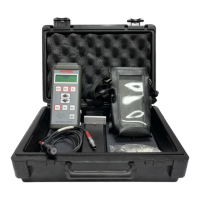4.1 Measurement method
The instrument uses a probe which is excited by an
AC signal (60 kHz “L” or 500 kHz “H”) from the main
unit. This AC signal uses the material to be measured
as a coupling medium to a detector coil also in the
probe. From the phase and amplitude of the detected
signal the instrument calculates the conductivity of the
coupling medium.
Only conductivity of non-magnetic metallic materi-
als can be measured using this system. Conductivity
changes considerably with temperature so the probe is
fi tted with a thermistor. It’s temperature is monitored in
order to display a mathematically adjusted conductivity
reading relative to 20 °C. The instrument will indicate
the necessity for a Probe Reset after a temperature
change of +/–3 °C. The set routine should be carried
out just before a measurement if absolute accuracy is
required.
A certain amount of surface unevenness and nonmetallic
coatings up to 0.020" (0.5 mm) are allowed for in the
measurement system (0.010" (0.25 mm) only with the
8 mm probe). When the probe has exceeded this “lift-
off” distance, PROBE OFF METAL will be displayed.
4.2 Display
The display is a back lit LCD, the back light can be set
ON or OFF. When in Measurement Mode the display
will indicate the numerical value of the material being
measured in % IACS (I) or MegaSiemens/meter (S)
depending on the units selected. PROBE OFF METAL
is displayed if the probe is in air and not in close prox-
imity to a measurable material.
Other display modes can be selected which are used
for setting up operational parameters, or logging fi les
(see chapter 5). In these Modes the display will high-
light the parameter being set and its current status. In
the measurement mode Alarm States are indicated
by icons at the bottom of the display. The frequency,
probe code selected, measurement units and state of
charge of the battery are also shown at the bottom of
the display.
Measurement method
Basic functions
4 - 2
Issue 04, 06/2007 AutoSigma 3000

